Why a Walk-In Fridge is Your Smart Cold Storage Solution
Looking for a walk in fridge for your business? Here's what you need to know:
| Walk-In Fridge Essentials | Details |
|---|---|
| Typical Sizes | From 36 sq. ft. (6'×6') to 1,600+ sq. ft. |
| Standard Temperature | 41°F (5°C) for optimal food safety |
| Insulation | 2-4 inches of polyurethane insulation |
| Average Lifespan | 15+ years with proper maintenance |
| Starting Price | Around $5,951 for a basic 6'×6'×7'4" unit |
| Key Applications | Restaurants, supermarkets, mortuaries, floral shops |
A walk in fridge represents a pivotal investment for establishments requiring large-scale cold storage solutions. Unlike standard refrigerators, these spacious cooling chambers provide ample room for bulk storage, easy organization, and efficient accessibility—allowing staff to literally walk inside to retrieve items. With customizable dimensions, temperature controls, and specialized features, walk-in coolers have become essential infrastructure for businesses handling perishable goods.
The versatility of walk-in refrigeration extends beyond restaurants and supermarkets. These cooling solutions serve diverse applications including mortuary services, floral preservation, brewery operations, and laboratory environments where precise temperature control is critical. With proper installation and maintenance, a quality walk-in fridge can provide reliable service for 15+ years, making it a sound long-term investment.
Modern walk-in fridges combine energy efficiency with robust construction, featuring thick insulated panels and reliable refrigeration systems that maintain consistent temperatures. Whether you need a compact 36 sq. ft. unit or an expansive 1,600 sq. ft. cold storage warehouse, today's market offers options to fit virtually any space requirement and budget.
I'm Mortuary Cooler, a national-level supplier of walk-in refrigeration systems with specialized expertise in mortuary applications and walk in fridge solutions for various industries. My experience has shown that selecting the right cooling solution begins with understanding your specific storage needs and space constraints.
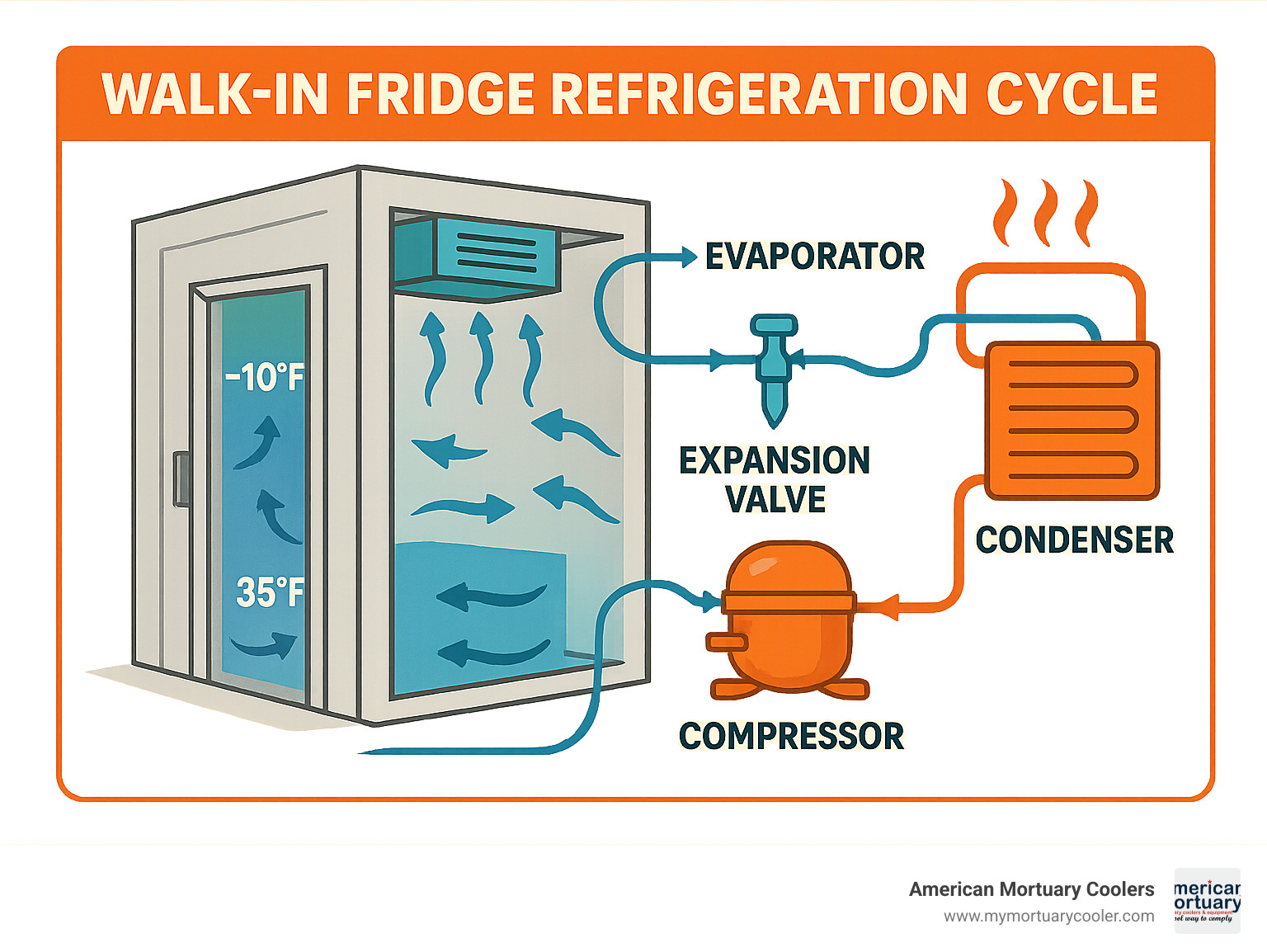
Walk in fridge basics:
Model 1: ColdFusion Pro 8' × 10' Walk In Fridge
If you're looking for the perfect mid-sized walk in fridge that balances space with efficiency, the ColdFusion Pro deserves your attention. With its generous 8' × 10' dimensions, you'll enjoy 80 square feet of accessible cold storage—plenty of room to transform how you manage inventory while keeping everything at food-safe temperatures.
Key Features:
When I visited a client's ColdFusion installation last month, I was impressed by the thoughtful design elements that make this unit stand out. The R-29 rated 4" thick foamed-in-place urethane panels exceed Department of Energy standards, keeping the cold in and your energy bills down. The pre-wired, vapor-proof LED lighting brightens every corner without driving up electricity costs.
One feature business owners particularly appreciate is the remote condenser design. By separating the cooling mechanism from the storage area, the unit runs quieter and doesn't add heat to your facility—a smart touch that makes a real difference in daily operations.
The cam-lock panel system is another highlight, allowing for quick assembly and giving you flexibility if you need to expand or relocate in the future. And with NSF #7 certification, you can be confident your unit complies with strict food safety and sanitation standards. Need it fast? The quick-ship availability means your unit can arrive within 14 days, keeping your project on schedule.
Michael, a craft brewery owner who installed the ColdFusion Pro last year, told me: "It's been a game-changer for our small brewery. The assembly was straightforward, and it maintains temperature perfectly. We've already recommended it to other brewers in our network."
Pros and Cons
What makes the ColdFusion Pro shine? Its spacious interior offers plenty of room for shelving systems, while the durable construction comes with a reassuring 20-year panel warranty. The energy-efficient design helps keep operating costs manageable, and most businesses find the assembly process surprisingly straightforward, even with minimal technical expertise. I also love that they include free PVC strip curtains—a simple but effective way to maintain temperature when the door is frequently opened.
Of course, no product is perfect. You'll need to ensure you have adequate ventilation space for the remote condenser. The initial investment is higher than reach-in refrigerators, though the long-term value makes up for it. Some customers opt for professional installation to ensure optimal performance, and like any refrigeration system, regular maintenance is necessary to maintain efficiency.
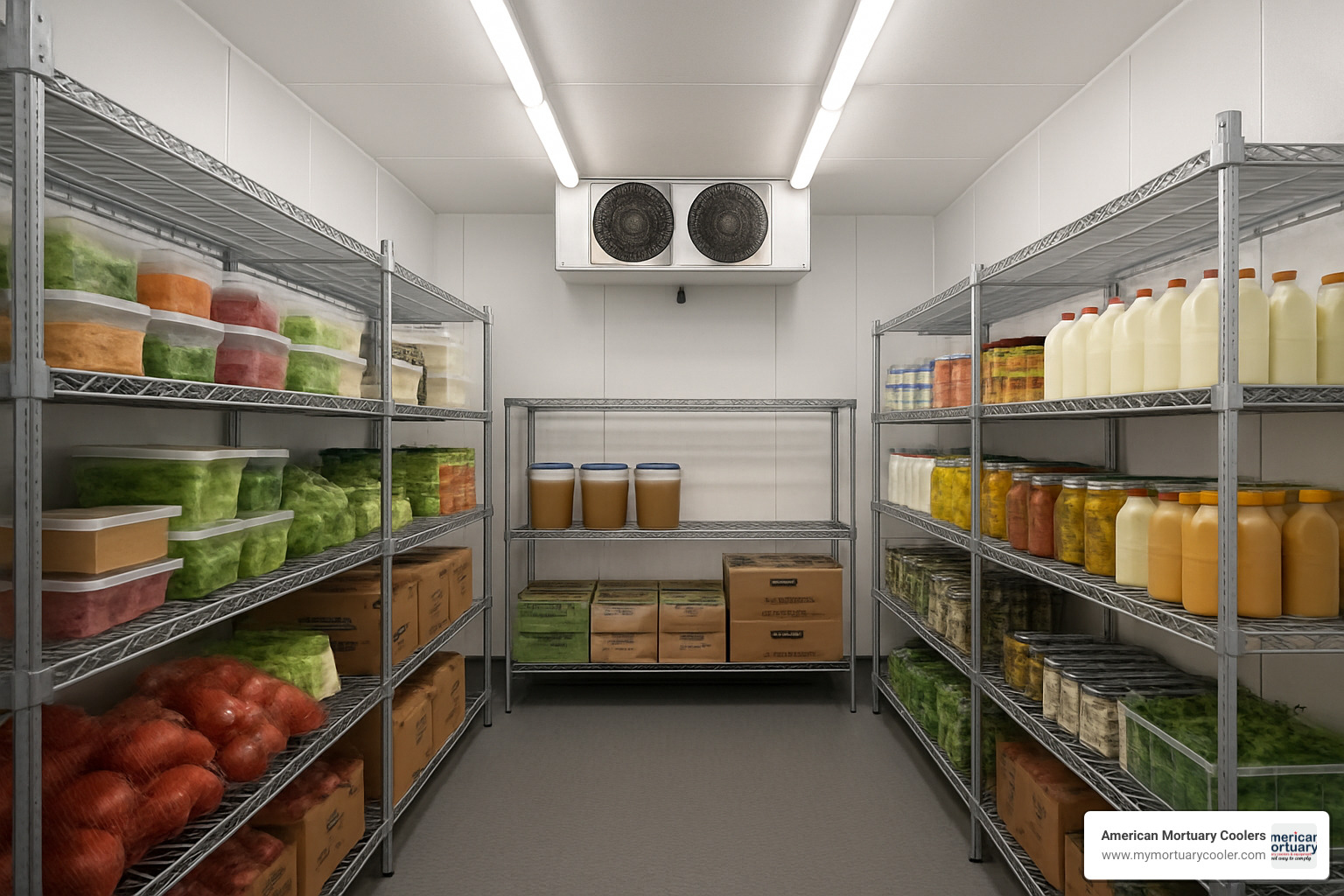
What truly sets the ColdFusion Pro apart is its thoughtful balance of quality construction and value. The standard heavy-duty floor handles up to 1,200 lbs of rolling load capacity—meaning your pallet jacks and heavy inventory won't be an issue. The digital temperature display lets you monitor conditions at a glance, while magnetic door seal gaskets and heavy-duty triple hinges ensure a tight, energy-efficient closure every time.
For businesses seeking reliable cold storage with room to grow, the ColdFusion Pro offers peace of mind with comprehensive warranty coverage: 20 years on panels, 5 years on the door and compressor, and 1 year on parts and labor. It's the kind of walk in fridge that becomes an essential part of your operation from day one.
Model 2: ArcticChef 6' × 8' Modular Walk In Fridge
When space is tight but your cold storage needs are growing, the ArcticChef 6' × 8' steps in as the perfect solution. This compact yet mighty walk in fridge brings commercial-grade refrigeration to smaller operations without breaking the bank or requiring extensive installation expertise.
Key Features:
With its clever plug-and-play design, the ArcticChef takes the headache out of upgrading to walk-in cooling. The self-contained refrigeration system sits neatly on top, maximizing your valuable interior storage space while maintaining a steady 41°F throughout. The high-performance polystyrene panels (2-4 inches thick) keep the cold in and your energy bills down.
Every detail of this unit is designed with efficiency in mind. The self-closing door gently swings shut if left open, while the included vinyl strip curtain allows staff to move in and out while minimizing temperature fluctuations. The energy-smart digital controls put you in command of performance settings, helping you balance perfect cooling with reasonable operating costs.
"For small restaurants like ours, this unit hit the sweet spot between capacity and cost," shares Kristina, a restaurant owner who made the switch last year. "The self-contained system meant we didn't need to hire a specialized technician for installation, which saved us even more."
Priced at approximately $5,951.23 for the 2023 model, the ArcticChef represents real value for businesses ready to move beyond multiple reach-in units. Florists, small caterers, and boutique eateries find this model particularly well-suited to their growing needs.
ArcticChef vs. Standard Household Refrigeration
| Feature | ArcticChef Walk-In | Typical Household Refrigerator |
|---|---|---|
| Storage Capacity | 48 sq. ft. | 15-20 sq. ft. |
| Organization | Walk-in access, customizable shelving | Fixed shelves, limited configuration |
| Temperature Stability | ±1°F variation | ±3-4°F variation |
| Energy Efficiency | Higher initial cost, lower per-cubic-foot operating cost | Lower initial cost, higher per-cubic-foot operating cost |
| Lifespan | 15+ years | 8-10 years |
| Bulk Storage | Can accommodate full-size sheet pans, cases | Limited to consumer packaging sizes |
| Cooling Mechanism | Commercial-grade condenser and evaporator | Residential compressor system |
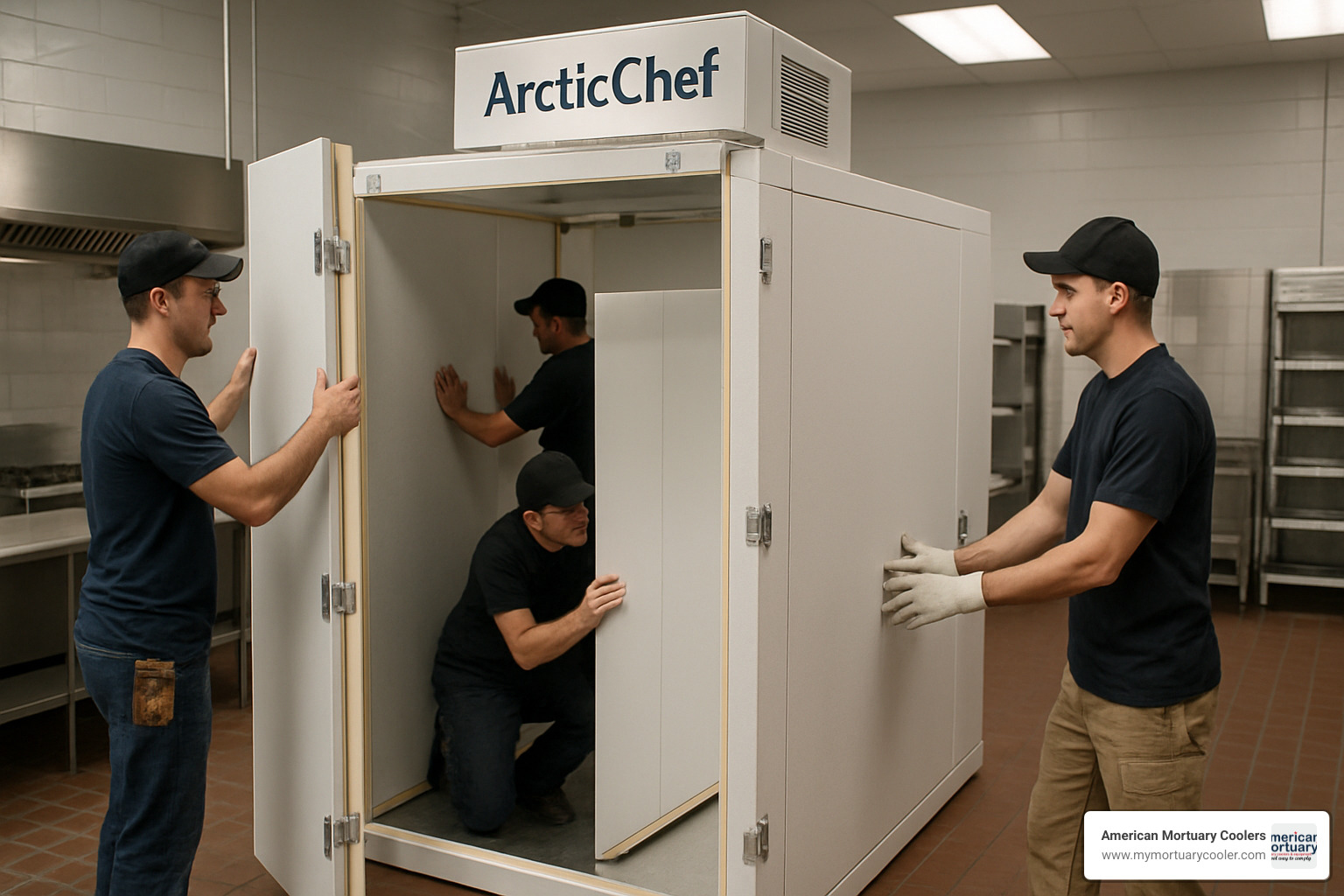
The ArcticChef really shines in challenging spaces. Its modular design allows for installation in tight spots or buildings with limited access – perfect for urban restaurants or businesses in historic buildings with narrow doorways. You'll appreciate the whisper-quiet operation of the top-mount cooling system, which delivers consistent temperatures without disrupting your work environment.
The standard heavy-duty floor easily supports food service carts and moderate inventory weight, eliminating the need for custom flooring in most installations. And with both UL and NSF certifications, you can rest assured this unit meets all safety and sanitation requirements for commercial food storage.
For businesses making that critical first step from residential to commercial refrigeration, the ArcticChef offers the perfect balance of professional performance and practical design. It's the smartest way to multiply your cold storage capacity without multiplying your budget.
Model 3: FlexiFreeze 10' × 10' Combo Walk In Fridge
When your business demands versatility in cold storage, the FlexiFreeze 10' × 10' Combo walk in fridge delivers exceptional flexibility. This innovative dual-temperature unit brilliantly combines refrigeration and freezing capabilities in one efficient package, letting you handle different product requirements without installing multiple units.
Key Features:
- Dual-Temperature Capability: Enjoy separate cooler and freezer sections with independent controls that work in perfect harmony
- Outdoor-Rated Construction: Take advantage of the weather-resistant exterior that allows installation outside your facility, freeing up valuable indoor space
- Premium Insulation: Rest easy with superior R-29 insulation for cooler sections and improved R-32 rating for freezer sections
- Extended 20-Year Warranty: Benefit from industry-leading protection on insulated panels that demonstrates the manufacturer's confidence
- Cam-Lock Panel System: Experience peace of mind with tight seals and exceptional structural integrity
- Advanced Humidity Management: Say goodbye to frustrating ice buildup with technology that maintains optimal conditions
- Wide Temperature Range: Customize from -30°F to +86°F (-34.4°C to +30°C) to suit your exact needs
The FlexiFreeze represents the premium tier of walk-in refrigeration, offering maximum versatility for operations with diverse storage needs. Gene, a food distribution center manager who invested in the FlexiFreeze last year, couldn't be happier with his decision: "We use our FlexiFreeze for both fresh produce and frozen items. The dual-temp capability eliminated the need for separate units, saving us valuable space and simplifying our workflow."
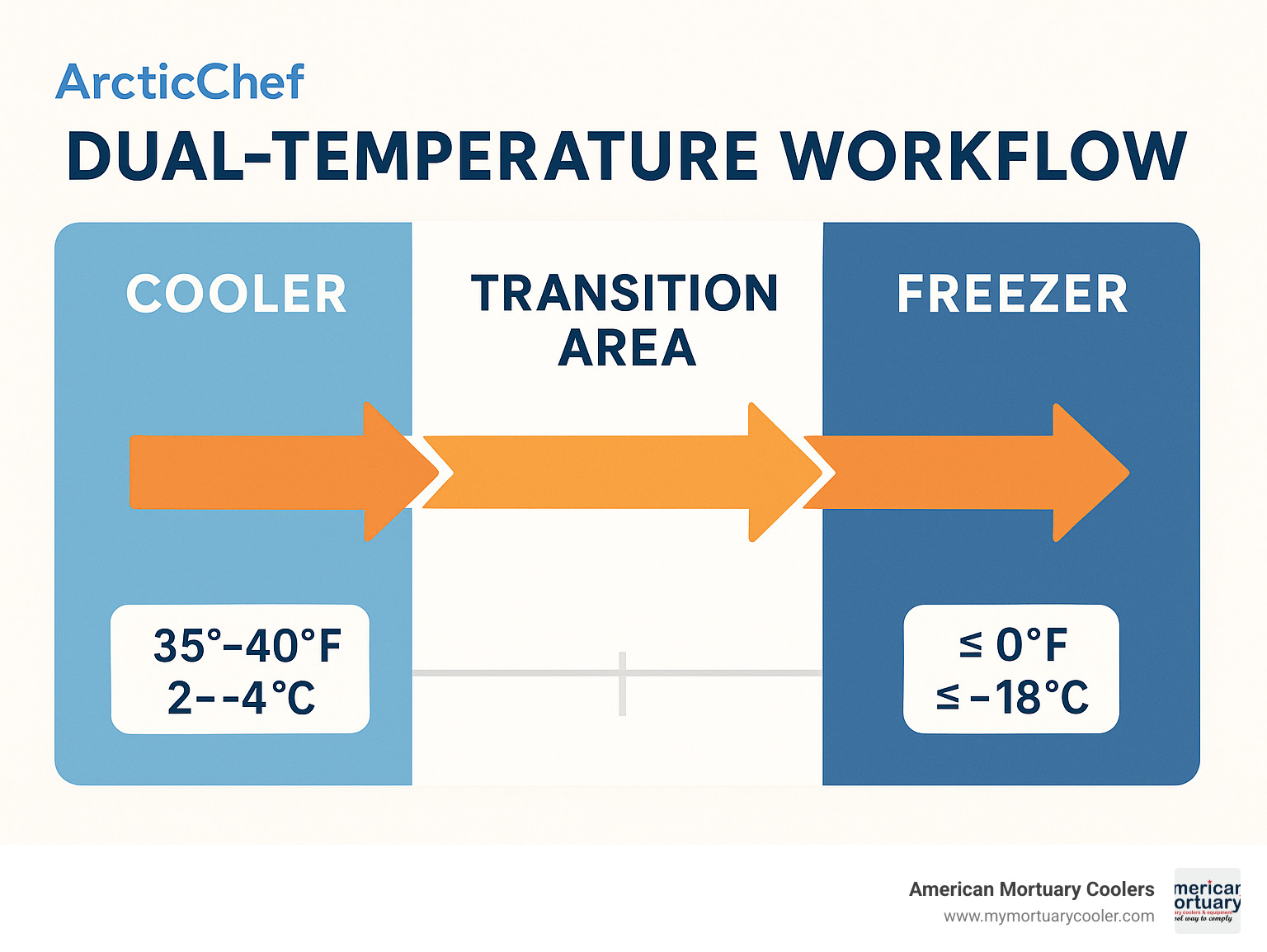
What makes the FlexiFreeze truly special is its separate refrigeration systems for each temperature zone. This thoughtful design maintains precise conditions in both compartments simultaneously. The freezer section features additional insulation to achieve the R-32 rating required by Federal EISA (Energy Independence and Security Act) standards, ensuring remarkable energy efficiency even when temperatures drop below zero.
For businesses with limited interior space, the outdoor rating of this model is particularly valuable. The robust weather-resistant exterior stands up to the elements with confidence, while the sophisticated refrigeration system automatically adjusts to ambient temperature changes. This placement flexibility can dramatically reduce the renovation costs typically associated with installing large refrigeration units indoors.
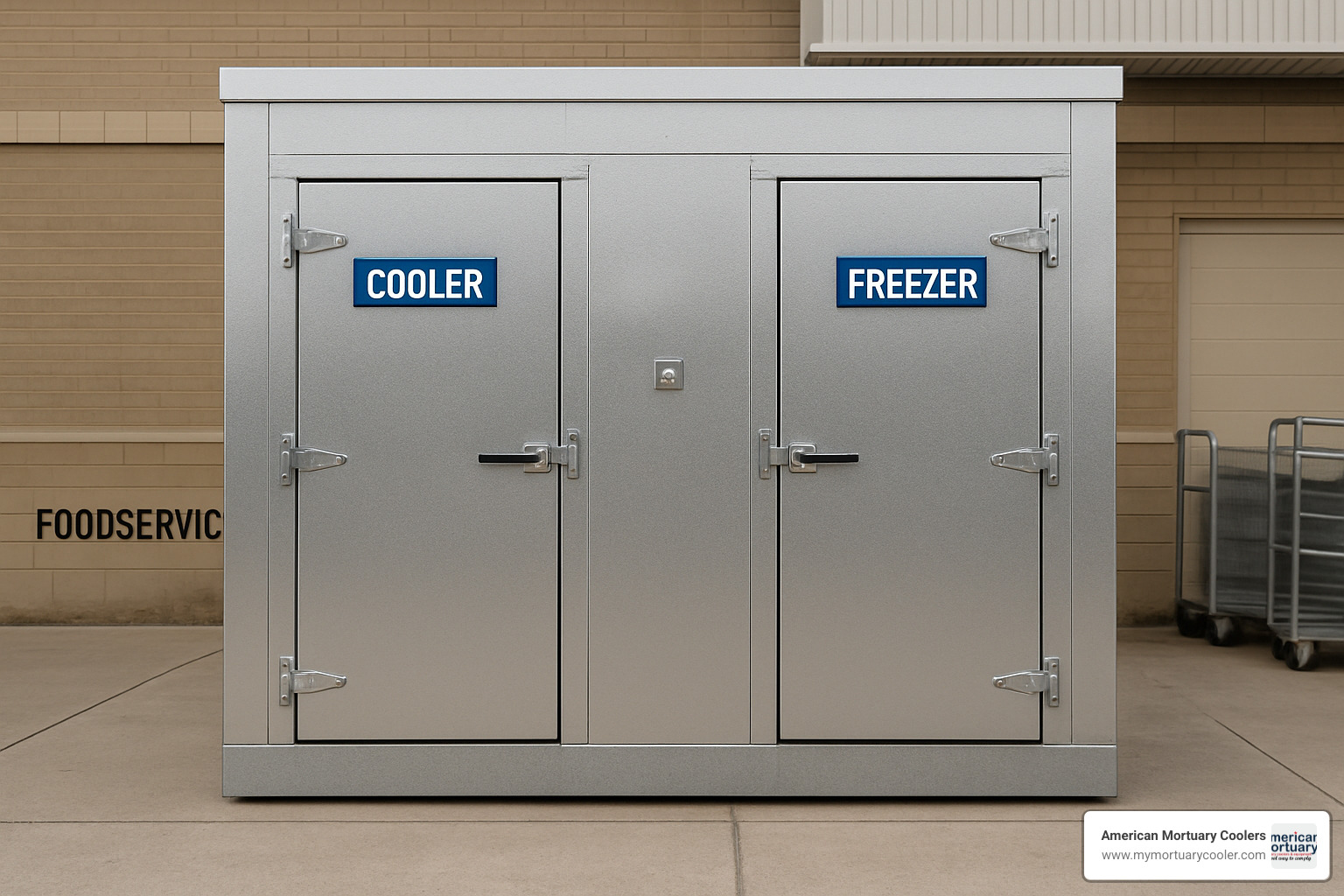
High-volume operations in foodservice, distribution, or specialized industries will find the FlexiFreeze combo unit provides a comprehensive solution that grows alongside your business. The clever modular design welcomes future expansion, while the dual-temperature capability accommodates changing inventory needs without requiring additional equipment purchases.
The humidity management system deserves special mention. By maintaining optimal moisture levels in each zone, it not only prevents ice buildup but also preserves product quality and extends shelf life. This feature is particularly valuable for businesses storing sensitive items that require specific humidity conditions alongside standard refrigerated products.
How to Choose & Install the Best Walk In Fridge
Choosing the perfect walk in fridge doesn't have to be overwhelming. Think of it as finding the right home for your perishables—it needs to fit your space, meet your needs, and work reliably for years to come.
Location Considerations
Where you place your walk-in can make or break its performance. Indoor installations need room to breathe—about 12-18 inches of clearance above and 3-6 inches on the sides. This space allows heat to escape rather than building up around your unit.
"One of the biggest mistakes we see is improper location planning," says Tamara, a refrigeration specialist I recently spoke with. "A walk-in generates significant heat through its condenser. Without proper ventilation, you're fighting against yourself, causing the unit to work harder and consume more energy."
If you're considering an outdoor installation, you'll need to think about weather protection, security features, and proper drainage. And regardless of location, consider your workflow—placing the walk-in closer to your kitchen improves efficiency but might expose it to more ambient heat.
Don't forget about floor strength! These units are heavy—typically requiring support for 300+ pounds per square foot when loaded with inventory. Your existing floor might need reinforcement to handle this weight safely.
Insulation & Energy Efficiency
The quality of insulation directly affects both your electric bill and how well your walk-in performs. Standard walk-ins feature 2-4 inches of polystyrene or urethane foam, but not all insulation is created equal.
For coolers, look for a minimum R-29 value, while freezers need at least R-32 to comply with EISA standards. The best panels use foamed-in-place insulation with thermal breaks that prevent cold from escaping and heat from sneaking in.
Don't overlook the small details—magnetic door gaskets, sweep seals, and strip curtains all play crucial roles in maintaining temperature. These seemingly minor components can dramatically impact energy consumption over time.
Size Selection Guide
Finding the right size is a bit like Goldilocks—too small and you'll outgrow it quickly; too large and you'll waste energy cooling unused space. Consider your business type when making this decision:
For small restaurants under 50 seats, a 6' × 6' to 6' × 8' unit with a self-contained refrigeration system usually works well. Mid-size restaurants with 50-150 seats typically need 8' × 8' to 8' × 10' walk-ins with split refrigeration systems and multiple shelving zones.
Larger operations like big restaurants or small grocery stores should consider 10' × 10' to 12' × 12' units, potentially with dual-temperature options. And for distribution or warehouse needs, 12' × 20' and larger units with remote refrigeration and pallet-compatible doors make the most sense.
"A properly sized walk-in should accommodate not just current needs but anticipated growth," a refrigeration expert told me recently. "Undersizing is one of the costliest mistakes in the long run."
Permits & Compliance
Before the first panel arrives, make sure you've covered the regulatory requirements. You'll likely need building permits for structural modifications, health department approval for food safety compliance, and electrical permits for power supply installation.
Don't forget about refrigerant compliance with EPA regulations and ADA accessibility if applicable to your business. Taking care of these requirements upfront prevents headaches and potential fines later.
Warranties & Financing
Quality walk-in fridges typically come with tiered warranty protection. Panel warranties generally run 10-20 years, door warranties about 5 years, compressor warranties around 5 years, and parts and labor warranties usually cover the first year.
The good news? Many manufacturers offer 100% financing options, making it easier to invest in quality equipment without depleting your operating capital. A small brewery owner recently shared, "The financing option was crucial for our startup. We were able to get a commercial-grade walk-in without draining our cash reserves."
For more insights on common misconceptions, check out Five myths about walk-ins. And for detailed pricing information, see The Complete Guide to Walk-In Cooler Features and Prices.
Which Walk In Fridge Size is Right for You?
Selecting the right dimensions means balancing your current needs with room to grow. Let's break down the common configurations:
Starter Units (36 sq. ft.) at 6' × 6' work beautifully for small cafés, boutique floral shops, bars needing backup storage, or specialty food producers. These compact units typically fit 2-3 shelving units while maintaining a walkway for easy access.
Standard Commercial (68 sq. ft.) units measuring 8' × 8' × 8' have become the popular choice for mid-sized restaurants, small catering operations, craft breweries, and mortuary facilities. With smart shelving, this size can replace 4-5 standard reach-in refrigerators while dramatically improving organization.
Warehouse/Distribution (400+ sq. ft.) operations often need walk-ins of 20' × 20' or larger to support food distribution centers, supermarkets, institutional kitchens, or manufacturing facilities. These heavy-duty units typically feature reinforced flooring for equipment and multiple access doors for efficient workflow.
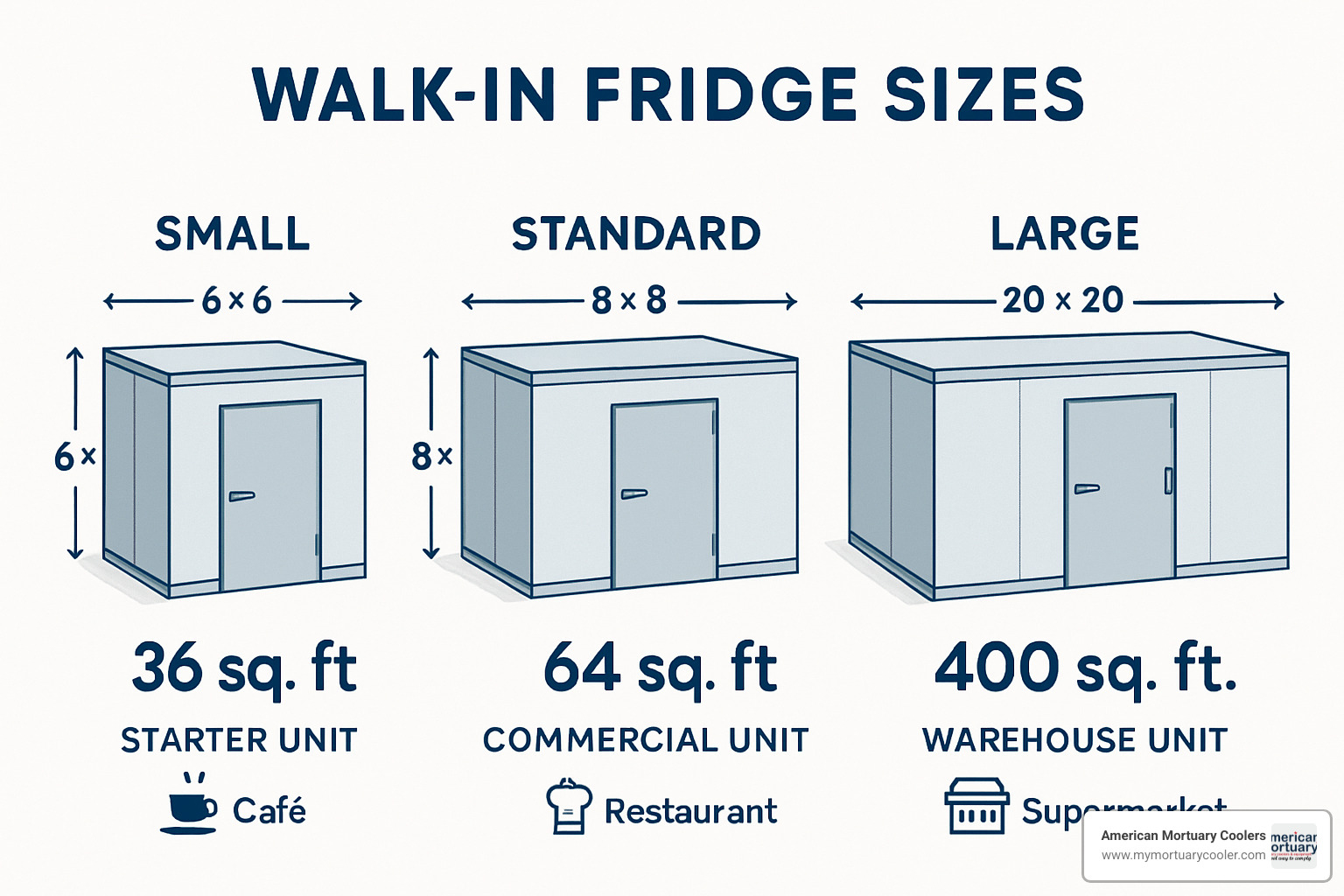
A refrigeration design specialist I work with always reminds clients, "When planning shelving layouts, remember to maintain a minimum 36-inch aisle width for comfortable access. Proper air circulation is also critical—keep products at least 4 inches from walls and ensure airflow around refrigeration components."
The beauty of modular systems is their flexibility. Most manufacturers offer panels in 1-foot increments, allowing customization for almost any space. Even unusual room configurations can be accommodated with custom-cut panels for sloped ceilings, support columns, or other structural elements.
Walk In Fridge Maintenance 101
A well-maintained walk in fridge can serve your business reliably for 15+ years, while neglected systems often fail prematurely and waste energy. Simple, regular maintenance makes all the difference.
Every 3-6 months, clean those condenser coils. It's like giving your walk-in a clear airway to breathe. Just shut down the unit, vacuum visible debris, and use a commercial coil cleaner. As one refrigeration technician with 20 years of experience told me, "Restaurant owners are often surprised when I show them their condenser coils. Just six months of dust buildup can dramatically impact performance. It's like trying to breathe through a pillow."
Monthly, check your door gaskets for tears or compression issues, and clean them with mild soap. Quarterly, inspect evaporator coils for ice buildup and clean drain lines. Seasonally, verify that defrost cycles are working properly.
Establishing a bi-annual service contract with a qualified refrigeration specialist is money well spent. They'll verify refrigerant levels, test thermostats, inspect electrical connections, and document everything for warranty purposes.
Modern walk-ins increasingly offer remote monitoring capabilities that track temperatures in real-time and send alerts before small issues become big problems. These systems can prevent product loss and equipment damage by catching problems early.
For budget-friendly maintenance tips, check out Walk-In Coolers That Won't Freeze Your Budget.
Budget & Operating Costs
Understanding the complete financial picture helps you make smarter decisions about your walk in fridge investment.
The initial investment typically breaks down into four components: the base unit (box) costing $5,951 to $12,778 for standard sizes; the refrigeration package running $2,500 to $6,000+; installation labor at $1,500 to $4,000; and accessories like shelving and lighting adding another $500 to $2,500.
A food service consultant I recently consulted put it perfectly: "When budgeting for a walk-in, the initial purchase price is just one component of the total cost of ownership. Energy efficiency features may increase upfront costs but can deliver significant savings over the unit's lifespan."
For ongoing expenses, expect electricity consumption of 50-90 kWh per day for an average cooler, with variables including size, insulation quality, ambient temperature, and usage patterns. Annual professional service runs $300-$600, with parts replacement in years 5-10 averaging $200-$500 annually.
The good news is there are potential savings to offset these costs. Many utility companies offer rebates of $500-$2,500 for energy-efficient models, and you might qualify for tax incentives too. Plus, you'll likely see reduced product loss from improved temperature stability and operational efficiency from better organization.
Most manufacturers offer 100% financing with terms from 24-60 months, making this essential equipment more accessible. As one restaurant owner shared, "The monthly payment on our financed walk-in was actually less than what we were spending on emergency service calls for our old reach-ins."
When looking at long-term value, a quality walk-in typically outlasts several generations of reach-in refrigerators, making it a sound investment for growing businesses.
Frequently Asked Questions about Walk In Fridges
How long does a walk-in fridge last with proper care?
With good maintenance, your walk in fridge can be your faithful kitchen companion for 15-20 years or even longer! The insulated panels are typically the most durable components, with manufacturers often backing them with impressive 20-year warranties. The refrigeration system itself has a shorter lifespan, with compressors typically needing replacement after 8-10 years of service.
Think of your walk-in like a car – how long it lasts depends largely on how you treat it. Regular maintenance makes all the difference in the world. A neglected unit might struggle to reach the decade mark, while a well-maintained system can serve your business for a generation.
"I'm still servicing walk-ins that were installed when flip phones were cutting-edge technology," laughs Miguel, a refrigeration technician with 25 years of experience. "The owners who follow the maintenance schedule religiously tend to get the most mileage from their investment."
One of the beauties of modular walk-in systems is that you don't need to replace the entire unit when one component fails. If your compressor gives up after a decade, you can upgrade just the refrigeration system while keeping the perfectly good insulated box structure – it's like getting a new engine for your car while keeping the same reliable body.
Can I put a walk-in fridge outdoors safely?
Absolutely! A walk in fridge can thrive outdoors with the right features. It's actually becoming increasingly popular as businesses look to maximize their valuable indoor square footage.
Outdoor-rated walk-ins come equipped with special weather-resistant superpowers: aluminum or galvanized steel exteriors with protective coatings, reinforced roofs that can handle snow loads, moisture-protected electrical components, and UV-resistant materials that won't degrade in sunlight. They also feature beefed-up security measures like heavy-duty locks to keep your inventory safe.
"Many of our clients actually prefer outdoor installation," explains Sarah, a refrigeration design consultant. "It not only frees up precious indoor space but also places the heat-generating components outside where they can operate more efficiently – it's a win-win."
Before you start planning that outdoor installation, though, check your local zoning regulations and secure any necessary permits. You'll also want to ensure proper drainage for defrost water and rain, and in extremely hot climates, providing some shade can help your unit run more efficiently.
Yes, outdoor-rated units typically cost about 10-15% more than their indoor counterparts, but many business owners find that the premium is well worth avoiding costly interior renovations or sacrificing valuable indoor space.
What certifications should my new walk-in fridge carry?
When shopping for a walk in fridge, certifications aren't just fancy badges – they're your assurance of safety, quality, and legal compliance. Think of them as the refrigeration equivalent of a chef's credentials.
The NSF International certification (specifically NSF #7) is perhaps the most important for food service operations, verifying that your unit meets strict sanitation requirements. This is what health inspectors look for, so it's essentially non-negotiable for food businesses.
Equally important is the UL (Underwriters Laboratories) listing, which confirms your walk-in meets electrical safety and fire resistance standards. Your insurer will thank you for this one!
Two other key certifications relate to energy efficiency: EISA (Energy Independence and Security Act) compliance ensures your unit meets minimum efficiency standards, while Department of Energy certification validates any energy performance claims.
"Think of certifications as insurance for your business," says Jamal, a food safety consultant. "They might seem like bureaucratic details, but they protect you from potential headaches with inspectors, insurance companies, and even lenders."
When reviewing manufacturer documentation, you might notice different components carry separate ratings – the panels, refrigeration system, and electrical components may each have individual UL listings that together make up a fully certified system.
Any reputable manufacturer should readily provide documentation of all applicable certifications. If they hesitate or can't produce these documents, consider it a red flag and continue your search elsewhere. Your peace of mind is worth it!
At American Mortuary Coolers, we ensure all our units meet or exceed industry certification requirements, whether they're destined for restaurant use or specialized applications.
Conclusion
Investing in a walk in fridge is truly a strategic move that goes far beyond simply storing cold items. Throughout this guide, we've seen how these versatile systems can transform businesses of all sizes—helping you better organize inventory, maintain food safety standards, and even save money through improved energy efficiency.
The three models we've highlighted each bring something special to the table. The ColdFusion Pro offers that perfect middle-ground solution with professional-grade features. The compact ArcticChef provides an affordable entry point without sacrificing quality. And the sophisticated FlexiFreeze gives you the ultimate flexibility with its dual-temperature capabilities. There's truly a perfect match for every business need.
When you're making this decision, the price tag is just one piece of the puzzle. A quality walk in fridge delivers value through energy savings, reduced product loss, and operational efficiency that compounds year after year. Think about the warranty protection, maintenance requirements, and whether you might need to expand in the future. These considerations help ensure you're making not just a purchase, but a genuine investment in your business's growth.
At American Mortuary Coolers, we've seen how the right refrigeration solution can make all the difference. While our specialty lies in creating custom mortuary coolers that we deliver nationwide across the 48 contiguous states, we understand that every industry has unique refrigeration challenges. Whether you're storing food, flowers, or medical supplies, finding the perfect cold storage solution matters to your bottom line and operational success.
I like to think of a well-chosen walk in fridge as a silent business partner – one that reliably shows up every day, keeps everything perfectly preserved, and never complains about working 24/7. With proper care, this partner will support your business operations for 15+ years, making it one of the smartest long-term investments you can make.
For those in the funeral industry looking for specialized solutions, we invite you to learn more about our premier walk-in body refrigerators designed specifically for mortuary and forensic applications.
A quality walk in fridge isn't just about keeping things cold—it's about creating the infrastructure that allows your business to maintain quality, support growth, and operate with maximum efficiency for years to come.


















